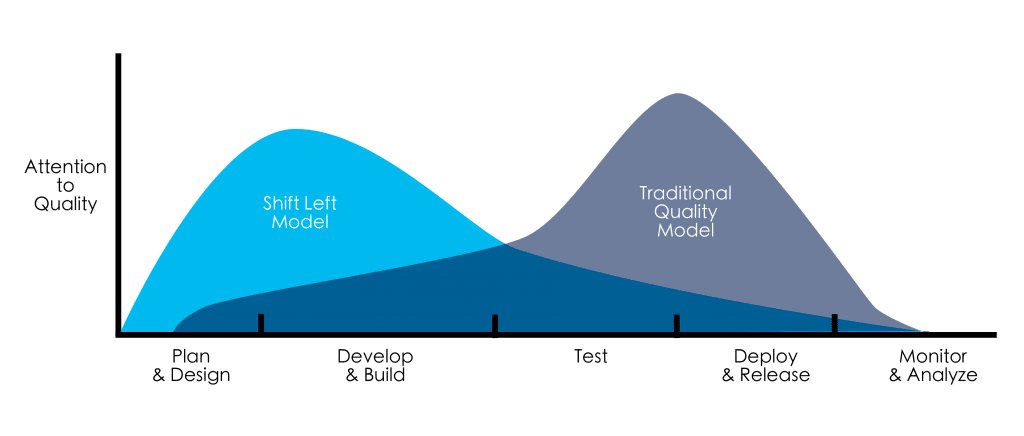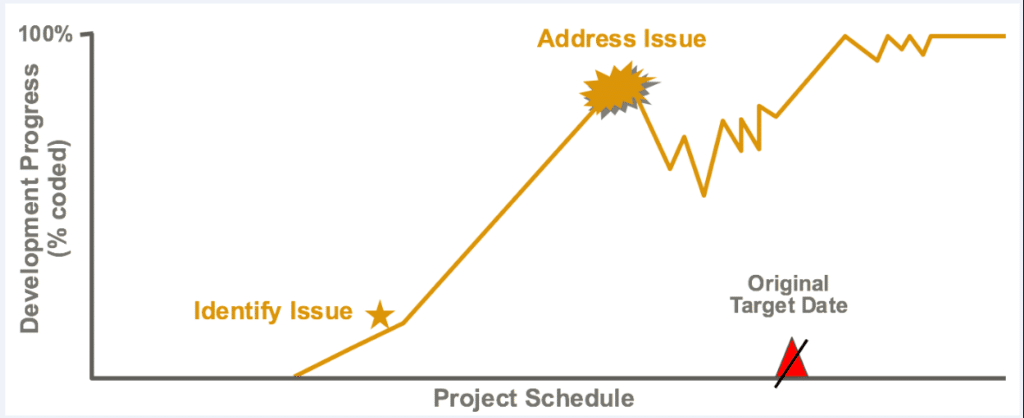Everything You should know about Shift Left Testing
The shift-left approach in the software development life cycle allows the team to understand the requirements, software design, architecture, and functionality to support the team. To provide support to the team, it also enables business analytics, seeks clarifications, and provides feedback wherever possible. This understanding and involvement lead the testers to earn complete information and knowledge about the product and to think through several scenarios. The real-time design is based on software behavior, which allows the team to spot flaws even before the siding is installed.
This insight and the important lesson learned sparked a significant change in the software industry and gave rise to the idea of “Shift Left,” which refers to moving the “Testing Phase” from the right to the left or including testing at every step and involving testers all the way through. Shift Left testing also refers to the practice of conducting ongoing tests rather than final ones.
Shift left concept introduction
Over time, individuals came to understand the value of software testing and the consequences of maintaining the “Testing Phase” at the very end or on the extreme right of the software development lifecycle. This realization resulted from the fact that it was extremely costly, labor-intensive, and time-consuming to address the faults at the very end and on the far right.
After a lot of time and effort, there have been occasions where a critical fault was not detected until the very last minute, preventing the release of mission-critical software. Since of this, when the error was found in the last phases of development, either the release was delayed or, occasionally, the software was abandoned because the effort required to fix it was just not worth it.
Shift left testing approach
The Shift Left movement urges us to rethink how we approach software quality improvement. We previously relied on a waterfall methodology, in which the roles and duties of developers and quality assurance experts were wholly distinct.

Shifting left refers to moving the testing phase of the software development life cycle (SDLC) earlier in the workflow. Teams that do this work together more effectively and communicate with one other more regularly.
Why adopt the shift left strategy?
Any problems that do exist are frequently more challenging to fix when testing is done at the end of the development period. The only solution to solve the issue is to entirely rethink the program and write new code because all of the code has already been written. As a result, costs rise and the time to market increases significantly.

Errors should be rectified as quickly as possible. Shift left testing is a technique that enables programmers to locate defects fast and often. Since these code chunks are small and easy to manage, the problems found while developers are creating or reviewing code are the simplest to correct.
After being combined with the main development branch, the breadth of the code and the time required to seek for bugs both rise. With this technique, quality assurance engineers will act more like experts, providing information and guidance across the SDLC.
Key features of shift left
- The shift left testing approach mainly focuses on involving the testers in all and most notably involved in the critical stages of the program.
- This approach enables the testers to divert their focus from defect detection to defect prevention and this led to driving the business goals of the program.
- The shift left testing approach offers high importance to the testing with which roles and responsibilities of the testers increase immensely.
- It does not end with the testers alone moving to the left and carrying out the testing activities continuously. This allows the developers to take more
ownership of their code and increase the responsibilities related to the test. - This approach encourages testers to adopt the behavioral-driven development BDD and Test-driven development TDD, which helps to prevent defect induction into the software.
- When the outcome of a location has an influence on the value of the final product, this approach demands testers to engage as early as possible in discussions and to work together on ideas that are necessary at every phase. This makes it easier for the project to find and foresee any additional hazards.
Advantages of shift left testing approach
Organizations may make quality a high priority from the start of a project and seek to find problems as early as feasible in the life cycle by employing the left shift testing strategy. The following are some of the main advantages of shifting left:
Enhances quality and efficiency
To produce high-quality software fast, shift left testing is necessary. Developers shift testing to the front of the process—or, more accurately, to the left—to minimize lengthy test cycles, eliminate faults, and manage risks earlier in the SDLC rather than later. This reduces rework and interruptions.
Reduces the cost of testing and development
Each construction should be examined to assist identify any issues so they can be fixed more inexpensively. By doing quality control as we go, we can avoid the exorbitant expenses and added labor of going back and starting over.
Provides competitive advantage
Shifting left gives you an advantage over your rivals and shortens your time to market. Development teams may move swiftly, establish, and keep their reputation by using incremental innovation. By moving left, the problem of accelerating advancement without sacrificing quality is solved.
Automation
You can more successfully automate testing by shifting to the left. Test automation decreases production issues, boosts coverage, and minimizes human mistakes in addition to giving testers more time to work on engaging and fulfilling tasks.
Fast delivery
Helps in delivering the product sooner within the market.
Challenges to shift left testing

Planning: Without a sound plan in place before you start, shift-left testing can be challenging to implement.
Managing a project: Make sure your project managers are properly trained and prepared to include shift-left testing into their operations.
Quality assurance: preserving high standards of quality while in the training and transitional phase
Developers: they may be reluctant to test, thus they should be ready to develop their testability abilities.
Reduce organizational silos so that you may give quick feedback and address issues more quickly and effectively.
Audits: Make sure this is set up to check the new testing approach is operating as planned if your firm does not actively participate in routine code audits.
When are bugs introduced within the code?
Although it is impossible to be precise, around 85% of code flaws are created during the coding process. Numerous bugs can also be discovered during the testing phase. At every cost, the bugs need to be resolved. This could not be made possible to properly solve all the big issues at once. But it reflects how crucial the introduction of testing is as early as possible in the software development cycle. For stabilizing the product, a lot of money and time has to be invested. The cost of detecting bugs and defects also varies at several stages of the software development cycle. The number can vary on average.
Steps to get ready to shift left with automation
The shift-left testing method is used as early as feasible in the development cycle. This in turn helps the teams focus on quality from the start of the project. Rather than waiting for the bugs to be discovered after the software development process has already begun.
Many organizations make the shift left in their development process, as testing and automation are no longer just QA functions. The role of developers is becoming a blur. There is some strategy that the team should adopt to make a smoother transition.
Ways to get started with shift left testing?
Here are some of the easy ways that could be adopted by the organizations to get started with shift-left testing.
Coding Standards
The development teams should agree on the same coding standards. The developers should communicate effectively to examine the code speed and ensure that it is of a better caliber. Coding standards need to decrease the number of bugs, and the standard should avoid bad or insecure code.
Implement Testing in Early Phases of the Development Cycle
The team should find out the tools which might be relevant for the codebase. Using a static code analyzer such as ESLint as it helps to detect bad coding practices and bugs while developing. The team needs to think about how they want to integrate testing in the early phase of the software development life cycle. This approach is used for the agile methodology, which uses a brief period for code development which could be defined as sprints. The development team can agree on writing unit tests for each of the features they develop. Which will ultimately help the testers to have confidence in the logic of the business that they write. To make sure the unit of code is properly integrated, the development team must create integration tests.
Embrace Test Automation
The shift-left testing approach includes frequent testing, and the team should embrace test automation tools. The deployment of new tools needs to be implemented for running integration and automation testing for all the codes. This allows to reduce the pressure on the testing team and gives feedback about the stability of the code very quickly.
Test automation speeds up the development life cycle and enables the testers to reduce the time to market. It thus ensures that fewer bugs are found in the later phase of the software development lifecycle.
The synergy between shifting left and agile
The agile system includes testing as an integral part of the shorter development cycle. This thus shifts lest testing fits nicely into the agile methodology. Each code increment, and two-week sprint, that requires testing must be completed momentously.
Many organizations like to push shift left testing towards the coding phase, and the right approach is test-driven development. This requires you to write the test for the piece of code which you want to develop. This allows verifying the validity of the code immediately.
Read more: How to increase Reuse through Auto Grouping?
What is done differently by the testers in the shift left approach?
Here are the key factors of what should testers do differently in the Shift Left Testing Strategy:
- The tester team needs to get engaged in the project right from its beginning.
- They need to gain adequate clarity on the programs
- Must adopt unified testing strategies
- Provide the highest level of test leadership and guidance to the entire team working with them.
- The tester team needs to analyze and review the entire requirement effectively.
- They need to bring preciseness and clarity to the work by pulling out real-time examples.
- Teams need to carry out static testing well in advance and also give feedback on key project documents so that defects can be prevented from getting grounded into the software and widening its effect later.
- Testers need to collaborate with the design and development team to provide the test scenarios in advance to create the code and address all possible real-time scenarios and business flows.
- Testers must create reliable test cases such that only a small number of flaws can be found during testing and that big errors or flaws may be avoided before the testing phase even begins.
- Testers have to test and be on a standalone or local system so that the defect does not get into further stages.
Make developers responsible for testing
Test automation is very crucial as Agile and DevOps require more automation. Automated tests that can be executed rapidly and accurately are required for these processes, such as continuous integration and delivery. Developers need to take responsibility for some of the automation efforts. If the testers are only held responsible for creating an automation framework and writing tests, then it will slow down the development process. Make sure to distribute testing to the developers, and this will help expedite your efforts.
Code review quality checks
Test automation of the sprint teams involved in all the test automation code reviews helps to guide the team with best practices for automation and testing. Developers submit the test for code review on individual sprints. Testers may certify that all necessary tests have been performed; no more situations that the developers could have overlooked need to be examined. It is advised that developers rather than testers provide the foundation for automations. The tester must focus on finding issues while working with software engineers who are more familiar with the code. Developers contribute to the testing efforts, and teachers will have more time to refer to good checks for the developer’s scripts and to focus on security or performance testing.
Read more: Automation Testing Process – Ways To Calculate The Cost & Expected ROI
Teach testers to code
The developers should take on some testing responsibilities, and testers need to do coding. To get effective code reviews, the tester needs to learn how to code. Testers need to be very technically proficient enough to read and modify code at the same level.
Use the same tools
Testers create automation frameworks from scratch by using tools. Popular test tool vendors support programming languages like Java and C#. Many of them integrate with the popular developer’s IDEs and source control software. Make sure to use tools that fit into the developer’s ecosystem if you are starting the automation efforts.
Start with testability in mind
After a sprint, testing shouldn’t be left up to one dedicated tester. Developers are responsible for the vast majority of test automation frameworks. This in short makes them aware of all the problematic issues that can cause unreliable tests due to poor application testability code.
Is shift left testing worthy?
Shift left testing entirely depends on the organization. Every organization can move towards shift-left testing. You can start by introducing coding standards or embracing a static analysis tool. The benefits of shift left testing are very clear, and detecting and reducing the number of bugs early on in the software development life cycle. You can make sure of a higher quality of code. The development team will save time and money by embracing testing in the early stages of software development. Therefore yes, shift left testing is worthy.
Sum-up
The shift-left testing concept brings an enormous transformation to the entire testing role. The sole focus of the shift-left testing is the defection of the defect. Now the aim of the shift left from the perspective of testing is a journey of early defect detection to defect prevention. It is a big leap in the software industry in the development methodology of software towards speed to market and improved quality. It also reduces the time to market scenarios. So, you can hire Amplework for this testing purpose.
The QA team plans to offer a wide range of QA testing services for many industries in order to assist organisations in developing a QA programme. We also provide manual testing, automated testing, mobile device testing, API testing, QA analysis, and other QA services.
Contact Amplework Software right now to find out more about how we may aid in resolving your testing difficulties.



 sales@amplework.com
sales@amplework.com
 (+91) 9636-962-228
(+91) 9636-962-228





